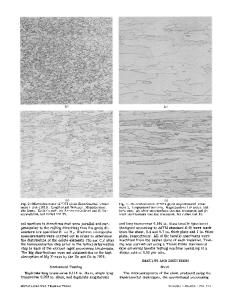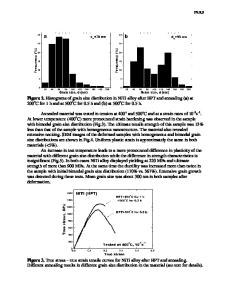Effect of WC grain size on mechanical properties and microstructures of cemented carbide with medium entropy alloy Co-Ni
- PDF / 6,395,161 Bytes
- 12 Pages / 595.22 x 842 pts (A4) Page_size
- 76 Downloads / 335 Views
Effect of WC grain size on mechanical properties and microstructures of cemented carbide with medium entropy alloy Co-Ni-Fe binder QIAN Cheng(钱铖)1, LI Kun(李昆)1, GUO Xue-yi(郭学益)2, LIU Bin(刘彬)1, LONG Zheng-yi(龙郑易)1, LIU Yong(刘咏)1 1. State Key Laboratory of Powder Metallurgy, Central South University, Changsha 410083, China; 2. School of Metallurgy and Environment, Central South University, Changsha 410083, China © Central South University Press and Springer-Verlag GmbH Germany, part of Springer Nature 2020 Abstract: For developing new binder phase with high performance, Co-Ni-Fe alloy was used as binder in cemented carbides. The mechanical properties of WC-CoNiFe and WC-Co cemented carbides with different grain sizes were studied. The results show that the reprecipitation of WC-CoNiFe is inhibited compared with that of WC-Co during sintering process, and the grains in WC-CoNiFe cemented carbides are more of smooth shape, resulting in a slightly lower hardness and higher transverse rupture strength. With the increase of the grain size, the hardness of the two cemented carbides decreases, and the transverse rupture strength increases. However, the slope values of K in Hall-Petch relationship are higher in WC-CoNiFe than those in WC-Co, indicating the high toughness of medium entropy alloy Co-Ni-Fe. Key words: cemented carbides; mechanical properties; dissolution-reprecipitation; Hall-Petch relationship; medium entropy alloy Cite this article as: QIAN Cheng, LI Kun, GUO Xue-yi, LIU Bin, LONG Zheng-yi, LIU Yong. Effect of WC grain size on mechanical properties and microstructures of cemented carbide with medium entropy alloy Co-Ni-Fe binder [J]. Journal of Central South University, 2020, 27(4): 1146−1157. DOI: https://doi.org/10.1007/s11771-020-4355-5.
1 Introduction Conventional cemented carbides processed by powder metallurgy are based on refractory carbides bonded with a ductile Co phase [1, 2], due to its excellent yield strength, wettability and work hardening properties [3]. However, Co is expensive and scarce in resource, and its toxicity and pollution problems cannot be ignored [4−6]. Therefore, environmentally friendly cemented carbides with good performance and low cost have become an important research area. New binders for cemented carbides, such as Co-Ni, Ni, Fe, Fe-Ni, have been extensively studied. CHANG et al [7] found that the hardness and the
fracture toughness of WC-Ni-Fe were better than those of WC-Co at the same grain sizes. SU et al [8] found that Ni can improve simultaneously the hardness and the fracture toughness of WC-Co-Ni. However, some problems arise using these new binders. For example, although WC-Ni cemented carbides have higher fracture toughness than WC-Co, their hardness and transverse rupture strength are much lower. The grain size of WC-Ni increases easily, and mechanical properties are degraded [9]. On the other hand, the two-phase zone of WC-Fe alloy is very narrow, and the oxidation phenomena are very serious from powder preparation to sintering. The fluctuation of oxygen content
Data Loading...










